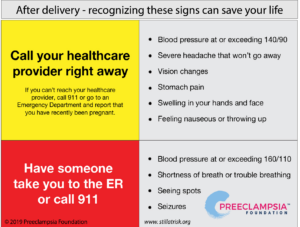Postpartum Preeclampsia: Moms are Still at Risk After Delivery
Most women with preeclampsia will deliver healthy babies and fully recover. However, some women will experience complications, several of which may be life-threatening. A woman’s condition can progress to severe preeclampsia, eclampsia, or HELLP syndrome quickly. Delivery, sometimes after a period of expectant management (“watchful waiting”), is a necessary intervention. Once delivered, mom still needs to receive care if she is experiencing high blood pressure and related preeclampsia symptoms.
It’s important to know that delivery is not the cure for preeclampsia. Any woman can develop preeclampsia after her baby is born, whether she experienced high blood pressure during her pregnancy or not. Moms need to continue to monitor their health after delivery. Recognizing these warning signs can save your life:


Postpartum Preeclampsia: Frequently Asked Questions
Postpartum preeclampsia is a serious condition related to high blood pressure.1 It can happen to any woman who just had a baby. It has most of the same features of preeclampsia or other hypertensive disorders of pregnancy, without affecting the baby.
Magnesium sulfate is started prior to delivery to reduce the risks of maternal seizures, eclampsia. Most protocols recommend continuation for 24 hours postpartum when the risk for seizures remains high. In some circumstances such as incomplete blood pressure control or a concerning clinical profile, treatment may exceed 24 hours.
Nutrition after giving birth is critical to good health. Brigham & Women’s Hospital offers this information about Postpartum Nutrition After Preeclampsia.
- 1Creanga, A. (2017). Pregnancy-Related Mortality in the United States, 2011-2013. Obstetrics & Gynecology, Page 6.
- 2Al-Safi, Z. E. (2011). Delayed Postpartum Preeclampsia and Eclampsia. ACOG, 1102-1107.
- 3Bigelow, C. A. (2014). Risk Factors for New-Onset Late Postpartum Preeclampsia in Women Without a History of Preeclampsia. AJOG
- 4Hypertension in Pregnancy: The Management of Hypertensive Disorders During Pregnancy. (2010). NICE Clinical Guildlines, 11
- 5Hebert, M. (2005). Pharmacokinetics and Pharmacodynamics of Atenolol During Pregnancy and Postpartum. Journal of Clinical Pharmacology, 45: 25-33.
- 6LactMed: Drugs and Lactation Database. (n.d.). Retrieved from Toxnet: https://toxnet.nlm.nih.gov/newtoxnet/lactmed.htm

